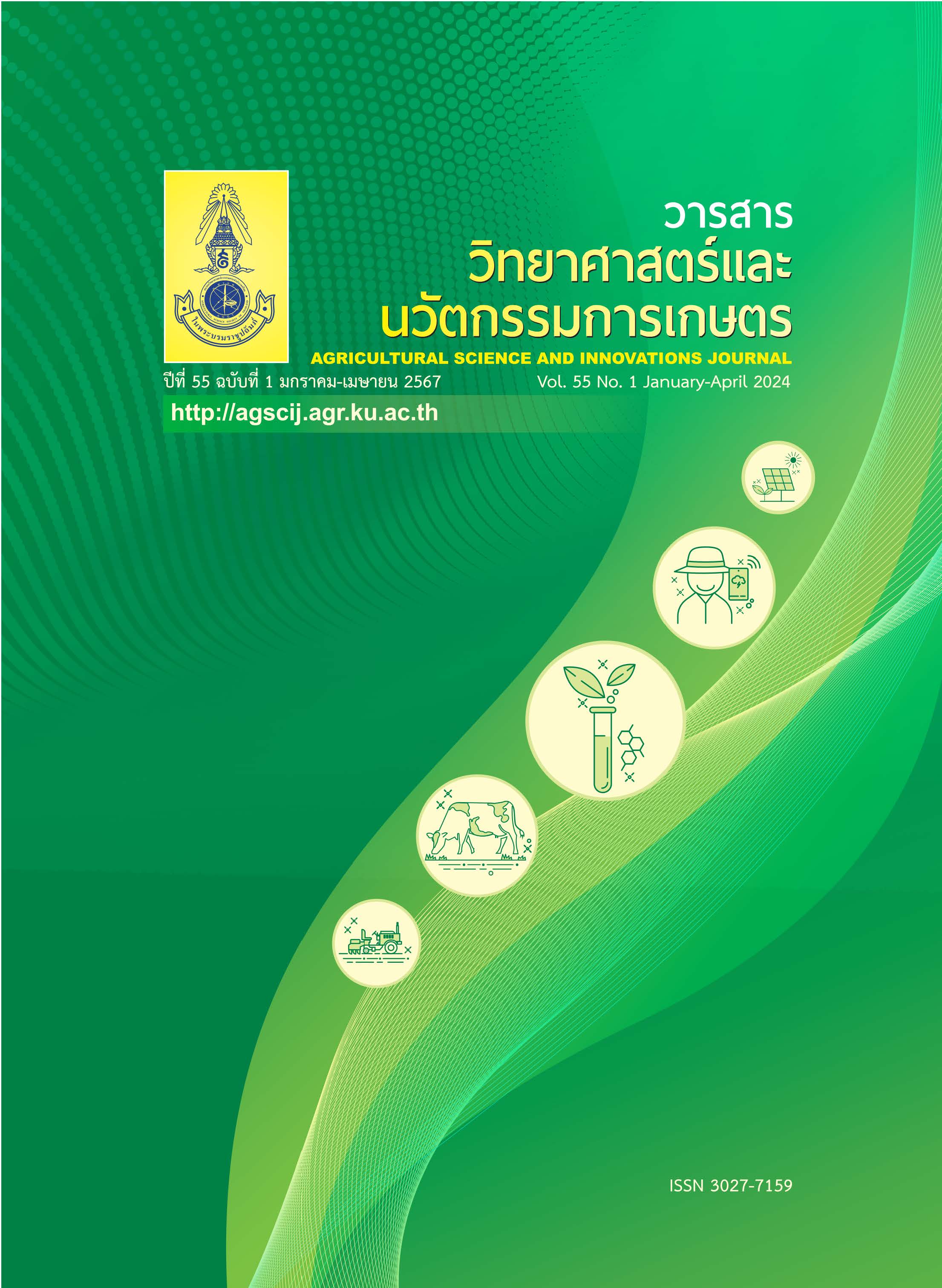การคาดการณ์ผลผลิตข้าวในประเทศไทยด้วยแบบจำลอง AquaCrop
Main Article Content
บทคัดย่อ
ความเป็นมาและวัตถุประสงค์: ข้าวเป็นพืชเศรษฐกิจที่สำคัญแต่การเผชิญภัยพิบัติที่เกิดจากการเปลี่ยนแปลงของสภาพภูมิอากาศ ภัยแล้ง และน้ำท่วม สร้างความเสียหายต่อผลผลิตเป็นอย่างมาก ด้วยเหตุนี้ งานวิจัยจึงมีวัตถุประสงค์เพื่อคาดการณ์ผลผลิตข้าวในอนาคต ให้เกษตรกรสามารถเตรียมความพร้อมต่อการปรับตัวในการทำเกษตรกรรม
วิธีดำเนินการวิจัย: การศึกษานี้ใช้ข้อมูลจากเกษตรกรปี พ.ศ. 2562 เป็นปีฐาน นำไปวิเคราะห์ร่วมกับข้อมูลสภาพภูมิอากาศรายวัน จำนวน 6 พารามิเตอร์ ได้แก่ อุณหภูมิสูงสุด-ต่ำสุด ปริมาณน้ำฝน ความเร็วลม ความชื้นสัมพัทธ์ และรังสีดวงอาทิตย์ ข้อมูลการจำลองสภาพภูมิอากาศในอนาคตจากแบบจำลอง PRECIS และข้อมูลการจำลองการปล่อยก๊าซเรือนกระจก (Special Report Emissions Scenarios: SRES) แบบการพัฒนาทางด้านเศรษฐกิจเป็นหลัก (A2) และการพัฒนาด้านสิ่งแวดล้อมที่ยั่งยืน (B2) พร้อมทดสอบความแตกต่างของค่าเฉลี่ยด้วยวิธี Least Significant Difference (LSD) ที่ระดับความเชื่อมั่นร้อยละ 95 และทดสอบประสิทธิภาพความถูกต้องของแบบจำลอง AquaCrop ด้วยการคำนวณค่าเฉลี่ยของเปอร์เซ็นต์ความคลาดเคลื่อน (Mean Absolute Percent Error; MAPE) ที่เปรียบเทียบผลผลิตจริงและผลผลิตที่คาดการณ์ด้วยแบบจำลองในปี พ.ศ. 2563 และ 2564 พบว่ามีค่าเฉลี่ย MAPE -0.10% ในรูปแบบ A2 และ -0.04% ในรูปแบบ B2 โดยค่าที่ต่ำแสดงถึงความแม่นยำสูง
ผลการวิจัย: ปีฐานมีผลผลิตข้าวเฉลี่ย 562.24 กิโลกรัมต่อไร่ เมื่อนำมาคาดการณ์ผลผลิตข้าวทั้งในรูปแบบ A2 และ B2 ปี พ.ศ. 2573 มีแนวโน้มเพิ่มขึ้นจากปีฐาน ได้ผลผลิตเฉลี่ย 646.00 และ 600.77 กิโลกรัมต่อไร่ ตามลำดับ เช่นเดียวกันกับปี พ.ศ. 2603 ที่มีแนวโน้มเพิ่มขึ้น ได้ผลผลิตเฉลี่ย 668.95 และ 669.16 กิโลกรัมต่อไร่ ตามลำดับ ซึ่งทุกคู่มีความแตกต่างกันอย่างมีนัยสำคัญทางสถิติ (P < 0.05)
สรุป: ผลผลิตข้าวในอนาคตที่ได้จากการคาดการณ์ด้วยแบบจำลอง AquaCrop มีปริมาณเพิ่มขึ้นจากปีฐาน โดยข้อมูลการเพิ่มขึ้นและลดลงของผลผลิตข้าวที่สามารถใช้เป็นแนวทางในการปรับตัวและวางแผนการทำเกษตรกรรมในอนาคต รวมถึงการจัดการพื้นที่ให้เหมาะสมต่อการปลูกข้าวของเกษตรกรต่อไป
Article Details

อนุญาตภายใต้เงื่อนไข Creative Commons Attribution-NonCommercial-NoDerivatives 4.0 International License.
เอกสารอ้างอิง
Anuluxtipun, Y. 2016. Basin-Wide Assessment of Climate Change Impact and Adaptation Options in Lower Mekong Basin. Mekong River Commission, Vientiane, Lao. 95 pp. (in Thai)
Anuluxtipun, Y., P. Phianphitak, P. Unjanam and P. Apiparinya. 2023. Forecasting sugarcane in Thailand with the AquaCrop model. Agricultural Sci. J. 54(3): 290–304. (in Thai)
Chidthaisong, A. 2010. Climate Change in Thailand. Volume 2 Climate Models and Future Climate. The Thailand Research Fund, Bangkok, Thailand. 176 pp. (in Thai)
Department of Land Development. n.d. Suitability of the soil Thailand’s agriculture. Available Source: http://iddindee.ldd.go.th/web/SoilData/1/pdf/05_กสด_ความเหมาะสมของดินด้านเกษตรกรรม.pdf, July 31, 2023 (in Thai)
Food and Agriculture Organization of the United Nations. 2015. AquaCrop. Available Source: https://www.fao.org/aquacrop/en/, July 31, 2023.
Haefele, S.M. and Y. Konboon. 2009. Nutrient management for rainfed lowland rice in northeast Thailand. Field Crops Res. 114(3): 374–385. https://doi.org/10.1016/j.fcr.2009.09.007.
Hsiao, T.C., P. Steduto, D. Raes and E. Fereres. 2009. AquaCrop—The FAO crop model to simulate yield response to water: I. Concepts and underlying principles. Agron. J. 101(3): 426–437. https://doi.org/10.2134/agronj2008.0139s.
Hydro - Informatics Institute (Public Organization). 2016. Records of drought events in 2015/2016. Available Source: https://tiwrm.hii.or.th/current/2016/drought59/drought59.html, April 19, 2023. (in Thai)
Inthavong, T., M. Tsubo and S. Fukai. 2011. A water balance model for characterization of length of growing period and water stress development for rainfed lowland rice. Field Crops Res. 121(2): 291–301. https://doi.org/10.1016/j.fcr.2010.12.019.
Lohmood, S. 2022. Testing the accuracy of predictive value. Available Source: http://eit.bsru.ac.th/wp-content/uploads/2022/03/การทดสอบความแม่นยำของค่าพยากรณ์.pdf, October 27, 2023. (in Thai)
Office of Agricultural Economics. 2019. Office of Agricultural Economics explains the cost of important agricultural products in 2019. Available Source: http://www.oae.go.th/view/1/รายละเอียดข่าว/Hot%20Issue/31442/TH-TH, May 1, 2021. (in Thai)
Office of Agricultural Economics. 2023. In-season rice: cultivated area, harvested area, production and yield per rai. Available Source: https://www.oae.go.th/view/1/ตารางแสดงรายละเอียดข้าวนาปี/TH-TH, April 19, 2023 (in Thai)
Souksomphan, T., N. Mahawan and C. Wanitlertthanasarn. 2023. Impacts and adaptations of rice farmers from climate change: case ctudy: Ban Sai Community, Muangxone, Huaphan province, Lao PDR. Journal of Social Sciences and Modern Integrated Sciences. 4(1): 54–64. (in Thai)
Sowcharoensuk, C. 2019. Rice industry. Available Source: https://www.krungsri.com/getmedia/c27bd671-84eb-4e9e-a9ee-20c718be0c39/IO_Rice_190814_TH_EX.pdf.aspx, May 1, 2021. (in Thai)
Srisomkiew, S., M. Kawahigashi, P. Limtong and O. Yuttum. 2022. Digital soil assessment of soil fertility for Thai jasmine rice in the Thung Kula Ronghai region, Thailand. Geoderma. 409: 115597. https://doi.org/10.1016/j.geoderma.2021.115597.
Srithamboon, S. 2011. Organic agriculture: a way of Thai farmers under global warming. Nakhon Phanom University Journal. 1(2): 24–30. (in Thai)
Sunthornsanan, C., N. Pumijumnong, P. Punwong and W. Wisawapipat. 2017. An assessment of rice yield under severe weather in the future under the A2 and B2 scenarios with EPIC model. In Proc. the 12th RSU National Graduate Research Conference 2017, August 17, 2017. pp. 1368–1375. (in Thai)


